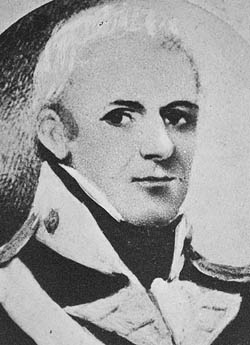Difference between revisions of "William Stewart's Shipbuilding Site"
| Line 1: | Line 1: | ||
Port Pegasus is a harbour located on the southeastern side of [http://en.wikipedia.org/wiki/Stewart_Island/Rakiura Stewart Island] and is believed to have been the first permanent European settlement on the island, though it is currently uninhabited. | Port Pegasus is a harbour located on the southeastern side of [http://en.wikipedia.org/wiki/Stewart_Island/Rakiura Stewart Island] and is believed to have been the first permanent European settlement on the island, though it is currently uninhabited. | ||
| − | == Site History == | + | == Site History== |
| − | [[Image:A020446.jpg|thumb|alt=William Stewart|Capt. William Stewart]] | + | [[Image:A020446.jpg|thumb|alt=William Stewart|Capt. William Stewart<ref>Image retrieved from http://adbonline.anu.edu.au/images/portraits/A020446.jpg on February 19, 2010.</ref>]] |
[http://www.nzetc.org/tm/scholarly/tei-MacHist-t1-body-d43-d1.html Captain William Stewart] first proposed colonization of Stewart Island in 1824 and, with the financial backing of Thomas and David Asquith (english merchants), embarked in January 1826 with a party of settlers (9 men and 9 [http://en.wikipedia.org/wiki/Maori Maori] women), as well as 6 months of supplies. | [http://www.nzetc.org/tm/scholarly/tei-MacHist-t1-body-d43-d1.html Captain William Stewart] first proposed colonization of Stewart Island in 1824 and, with the financial backing of Thomas and David Asquith (english merchants), embarked in January 1826 with a party of settlers (9 men and 9 [http://en.wikipedia.org/wiki/Maori Maori] women), as well as 6 months of supplies. | ||
| Line 13: | Line 13: | ||
The site was first suggested as being the location of William Stewart's shipbuilding site by Basil Howard in his book, ''Rakiura'' (1940). | The site was first suggested as being the location of William Stewart's shipbuilding site by Basil Howard in his book, ''Rakiura'' (1940). | ||
== Excavation == | == Excavation == | ||
| + | To verify that this was indeed the site of the first permanent settlement on the island and, subsequently, William Stewart's shipbuilding, field surveys and excavations were carried out from 8th-10th March 1994. | ||
| + | |||
| + | The many flat areas present suggested possible habitation, as well as what appeared to be the remains of a slipway, necessary for building boats. The areas chosen to be excavated were those that were visible features. Dense regrowth over most of the site led to the decision to use a tape and a compass as measuring instruments for this project<ref>McGovern, Richard. ''William Stewart's Shipbuilding Site. Port Pegasus, Stewart Island. Archaeological Survey.'' May 1994</ref>. | ||
| + | |||
| + | The evidence found, as well as the failures of Russell Beck and John Hall-Jones to find similar evidence of a slipway in a thorough search of the area, strongly supports the conclusion that this was the area of Stewart's first settlement. | ||
| + | == Notes == | ||
| + | <references/> | ||
| + | |||
| + | == Resources == | ||
| + | *McGovern, Richard. ''William Stewart's Shipbuilding Site. Port Pegasus, Stewart Island. Archaeological Survey.'' May 1994 | ||
Revision as of 00:12, 20 February 2010
Port Pegasus is a harbour located on the southeastern side of Stewart Island and is believed to have been the first permanent European settlement on the island, though it is currently uninhabited.
Contents
Site History

Captain William Stewart first proposed colonization of Stewart Island in 1824 and, with the financial backing of Thomas and David Asquith (english merchants), embarked in January 1826 with a party of settlers (9 men and 9 Maori women), as well as 6 months of supplies.
Originally attended to be a ship building site, a sealer named John Boultbee arrived at the Port to find the project abandoned and the settlers distraught for food, as Stewart had not returned with fresh supplies in over a year. They were forced to turn to any sustenance they could find in the area, mainly mussels and cockles. On a second visit, in 1828, Boultbee found them working on a second, smaller ship, though they had no nails or other standard building materials. They used wooden pegs to hold the ship together and flax for the sails and rope.
In 1829, William Cook (an English shipbuilder) found employment elsewhere and moved. Though some of the founding settlers remained there longer than him, the harbour is now uninhabited.
Upon the death of one settler, Benjamin Turner, many years later, his recollections of the experience were shared in The Daily Southern Cross newspaper.
The site was first suggested as being the location of William Stewart's shipbuilding site by Basil Howard in his book, Rakiura (1940).
Excavation
To verify that this was indeed the site of the first permanent settlement on the island and, subsequently, William Stewart's shipbuilding, field surveys and excavations were carried out from 8th-10th March 1994.
The many flat areas present suggested possible habitation, as well as what appeared to be the remains of a slipway, necessary for building boats. The areas chosen to be excavated were those that were visible features. Dense regrowth over most of the site led to the decision to use a tape and a compass as measuring instruments for this project[2].
The evidence found, as well as the failures of Russell Beck and John Hall-Jones to find similar evidence of a slipway in a thorough search of the area, strongly supports the conclusion that this was the area of Stewart's first settlement.
Notes
- ↑ Image retrieved from http://adbonline.anu.edu.au/images/portraits/A020446.jpg on February 19, 2010.
- ↑ McGovern, Richard. William Stewart's Shipbuilding Site. Port Pegasus, Stewart Island. Archaeological Survey. May 1994
Resources
- McGovern, Richard. William Stewart's Shipbuilding Site. Port Pegasus, Stewart Island. Archaeological Survey. May 1994